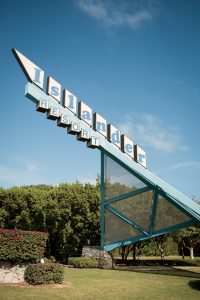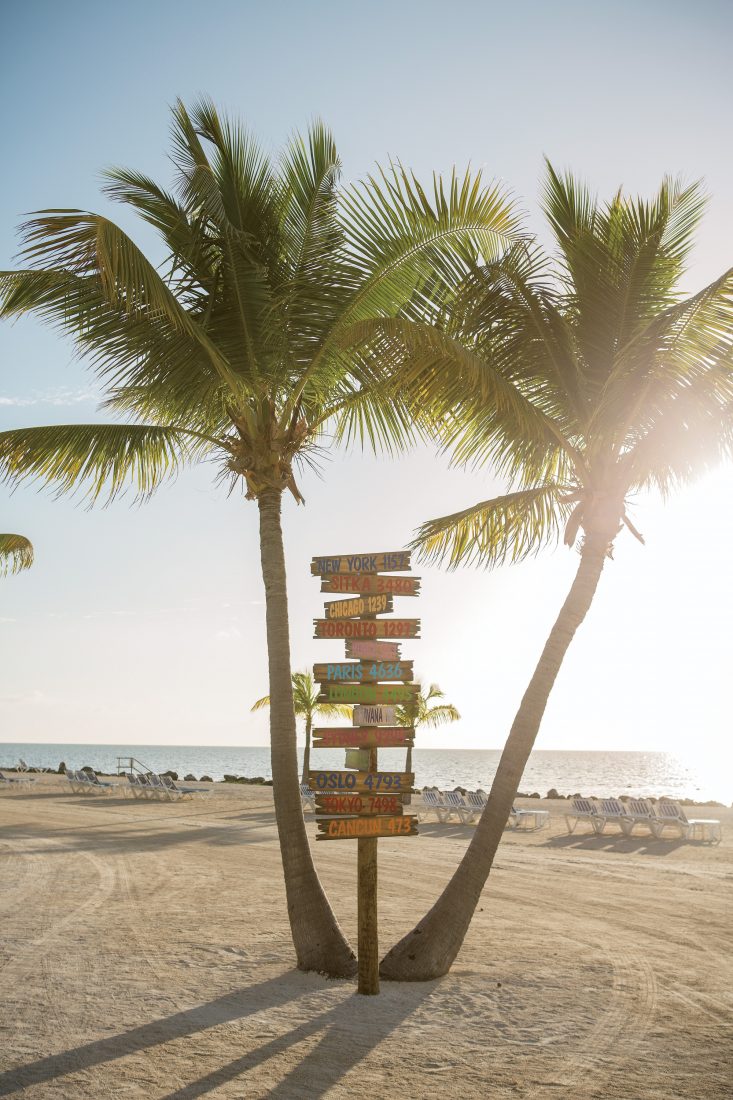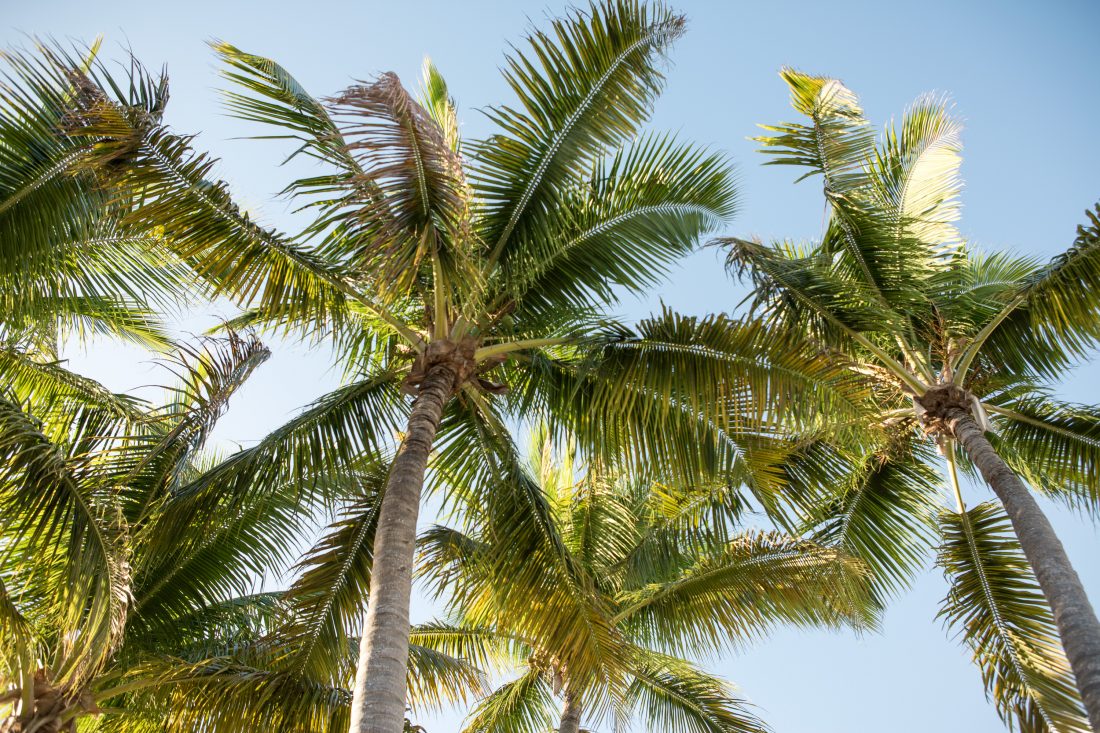Sporting
Fly Fishing’s All-Star Cast
Some of the world’s greatest anglers gather in the Florida Keys for a few days of instruction with some very lucky students
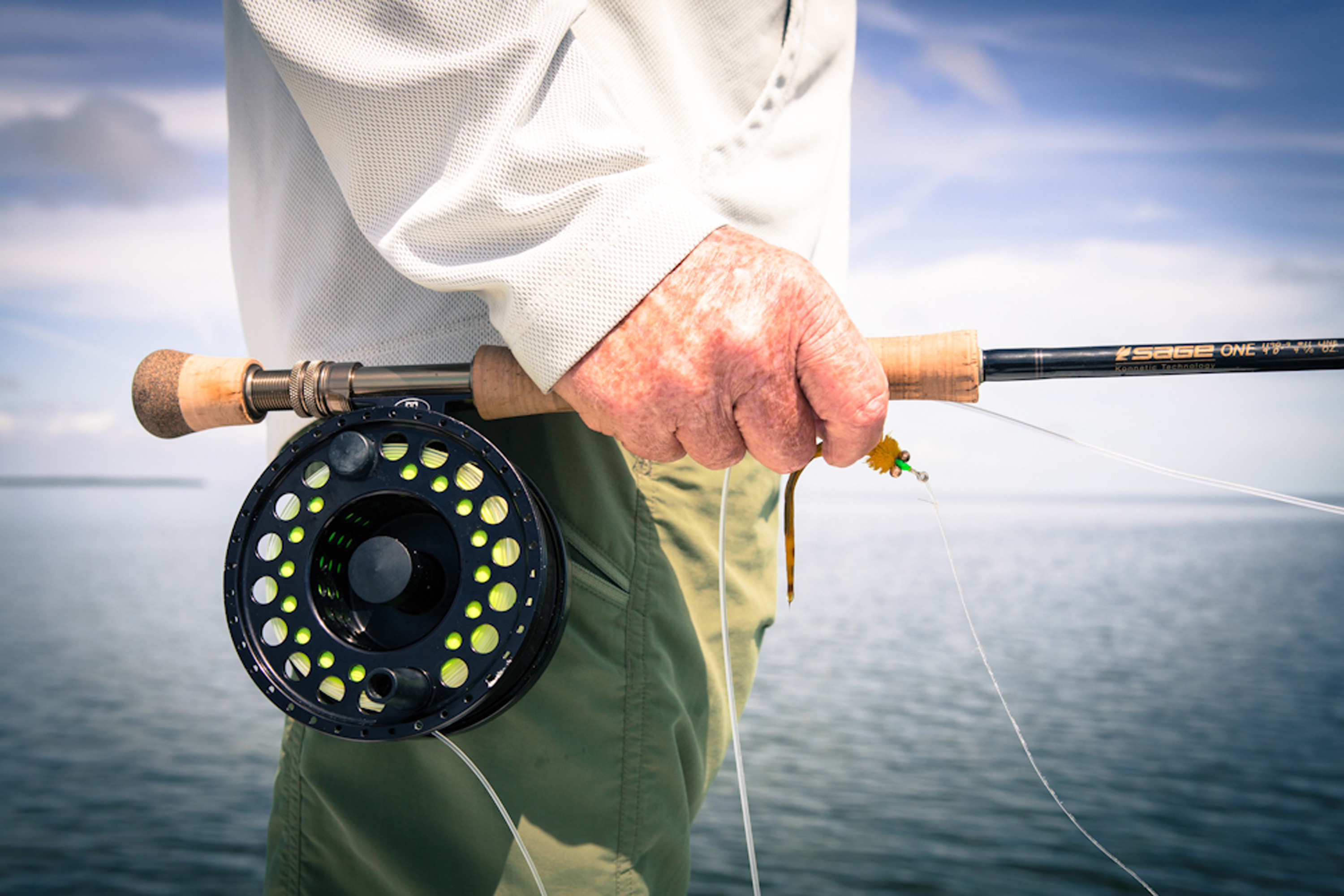
Photo: Eric Kiel
It is a flawless late winter Saturday morning in Islamorada, Florida, about half an hour before the twenty-fifth-anniversary session of Sandy Moret’s Florida Keys Fly Fishing School is due to kick off. On the beach of the Islander Resort, Steve Rajeff, one of the eight fly fishing all-star instructors in that school, is already out of the gate, giving a fly casting lesson and demonstration to a group of five early-bird students.
This scenario might be comparable to Tiger Woods teaching a little group how to swing a golf club, except that Rajeff is far more preeminent at his sport than Woods is at his. In fact, it is very likely that, at fifty-seven, Rajeff has absolutely dominated a particular sport (tournament fly casting) longer than any athlete who ever lived. For over four decades he has been the unquestioned best fly caster on the planet, with forty National Casting Championships and fourteen World Championships to his credit, as well as the record for the longest single-handed fly cast ever made: 243 feet. Which is about 143 feet longer than casters who are the equivalent of scratch golfers can make on their best days, and 200 feet longer than the casts now being pushed out by Rajeff’s students.
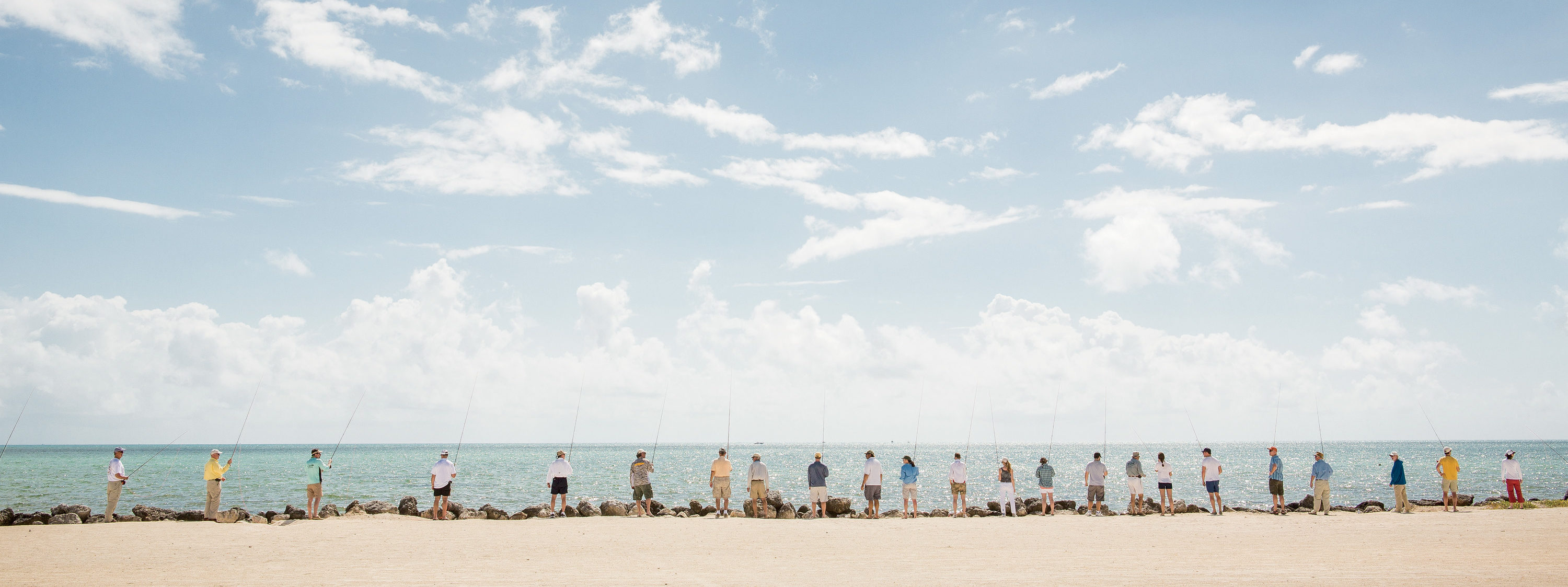
Photo: Eric Kiel
Master Class
Students line up to work on their casting technique.
“Try to get a little more zip in your stroke,” he says to one of them whose casts keep collapsing into the light breeze. Another, a right-handed caster, is having trouble with that breeze coming off his right shoulder and blowing the fly line into his body. Rajeff takes his rod and simply by turning his grip on it a quarter turn to the left is able to maintain a normal right-handed stroke while the fly line zips back and forth over his left shoulder, well away from his body.
Permit me a moment of reportorial disclosure here. I have been casting a fly rod with modest proficiency for over sixty years. For all of that time I have made casts in a right to left wind by crossing my right arm over my chest, thus putting those casts out of plane and disempowering them with less than a full back stroke. I was not a tuition-paying student, but had I been, I would have had my money’s worth out of this weekend before it even began.
Promptly at 9:00 a.m., in a fine big conference room at the Islander Resort, Sandy Moret starts things out by introducing himself and his seven fellow instructors to their pupils. Seated around three long conference tables arranged in a U and facing the instructors’ table, there are thirty-two of these pupils, six of them women, with an average age of thirty-five to forty, and ranging in fly rod experience from none to a lot. If they didn’t know it before, by the time Moret has finished with the introductions, the now wide-eyed matriculants are well aware that they are facing a table of Olympians—eight of the very best there ever were at what they do, owning among them (I did the math) somewhere north of 250,000 hours of saltwater fly fishing experience, up one side of the globe and down the other.
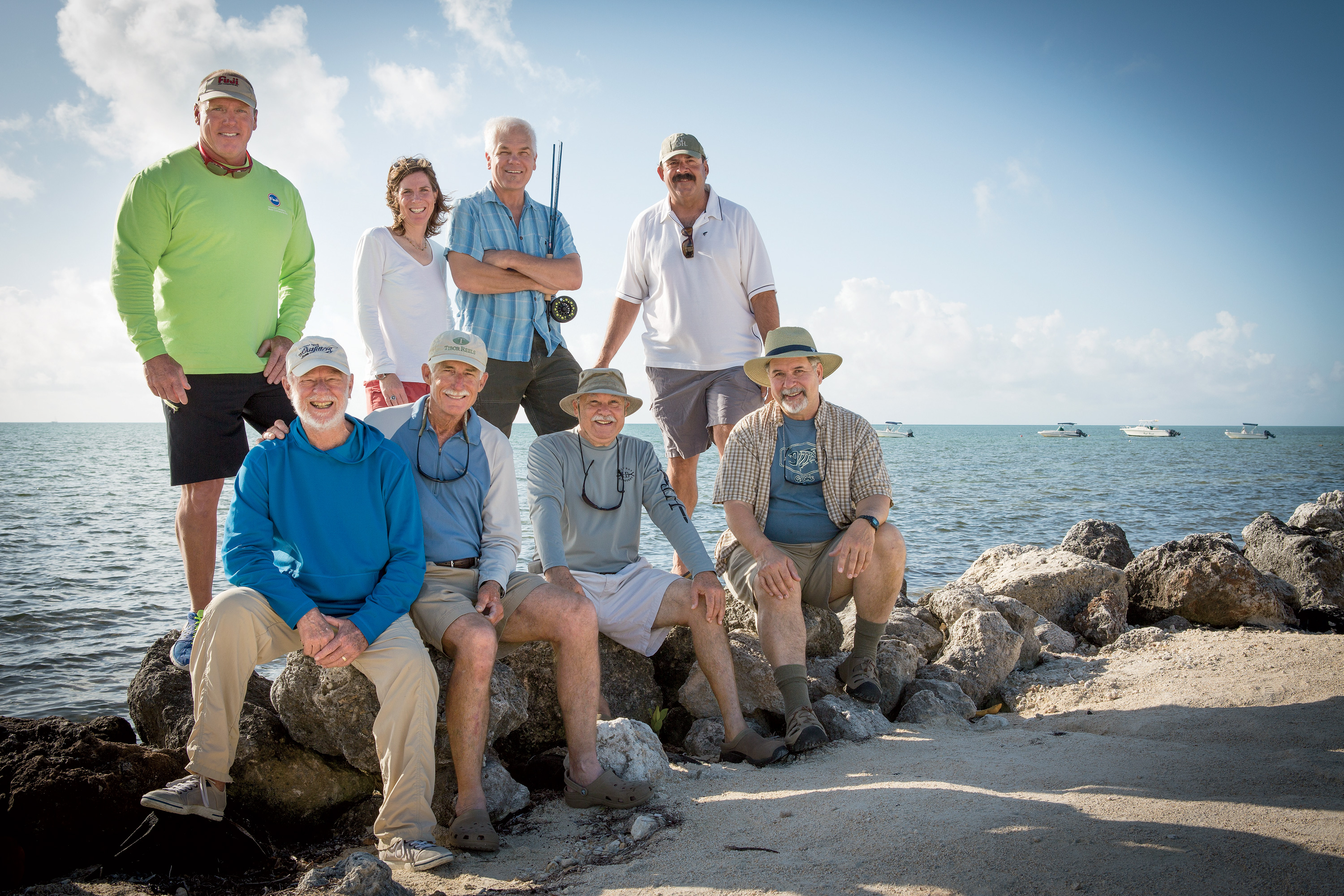
Photo: Eric Kiel
Left to right: Instructors Rob Fordyce, Diana Rudolph, Jerry Siem, and Tim Klein (back row); Sandy Moret, Steve Huff, Chico Fernandez, and Steve Rajeff (front row).
What the students get first is three half-hour, perhaps-more-than-they-want-to-know disquisitions on the tools of the trade—one each on fly rods, fly reels, and fly lines. Then each of them is given a rigged set of those tools (nine-foot, eight-weight G. Loomis or Sage rods, strung with Rio lines dyed fluorescent orange to make them easy to see in the air as they are cast), assigned along with three other students to one of the instructors, and led out to the beach for the first of four hour-long casting sessions.
I go with the group assigned to Captain Steve Huff. Over his forty-seven-year career, Huff has guided his anglers to more world records and major tournament wins than anyone in fly fishing history. He is the only guide ever admitted to the International Game Fish Association’s Hall of Fame and is universally regarded as the finest saltwater fly fishing guide ever to pole a skiff. At sixty-eight, he still guides more than two hundred days a year out of Everglades City, Florida, down from three hundred days per year for the twenty years he worked in the Keys. Huff has seen a few fly lines in the air, and within minutes he has identified the problems with his students’ casting and is on the way to correcting them.

Photo: Eric Kiel
Instructor Steve Huff works with students.
Huff has taught in every one of the Moret schools since their inception. At lunch I ask him what he has learned he can expect to accomplish with his students in two days. “I can develop their enthusiasm and get most of them casting well enough to fish,” he says. “We can tell them about the other stuff—learning to see fish, good presentation, working the fly in a realistic way. But all that takes time on the water to really learn. And the skill that takes the longest to learn is also the most important. That’s reading the shot—computing the direction and speed of the fish, its depth in the water column, the color of the water, the wind, the current, all in a few seconds, to know exactly where and when and how to present the fly. That’s the ability that separates out the very best anglers, and you can’t pick it up quickly or on dry land.”
Back in the conference room after lunch, Chico Fernandez gives an hour-long presentation on the patterns, sizes, materials, and specific uses of saltwater flies. As one of the finest saltwater flytiers alive, creator of such ageless patterns as the Bonefish Special and the Chico Snapping Shrimp, he is perhaps the best credentialed of the instructors to do this, and his brio and bone-deep knowledge and love of the subject matter make what could have been a quotidian hour seem too short.
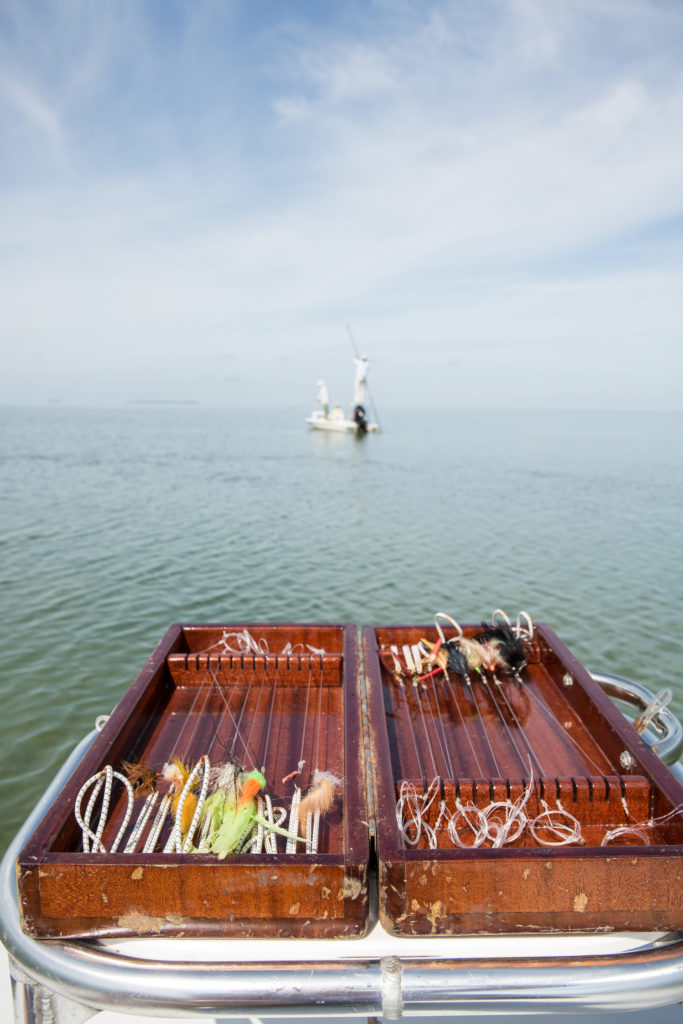
Photo: Eric Kiel
A box of flies ready at the ready.
Fernandez is a well-tended seventy-four and claims to have been the first fly fisherman in his native Cuba, his father having brought him a fly rod from America when he was sixteen, before fly rods were available in that country. Three years later, when Castro took over, Fernandez left Cuba for Miami and has lived there ever since, making a living by photographing, writing about, and teaching fly fishing in the salt, and setting seven fly rod world records while he was at it.
After his presentation, I follow Don Chico back out to the beach for the second casting session. “Timing,” he tells his four young male students, “is the most important element in your casting, not strength.” He demonstrates to them the timing of a good short stroke, then a longer one. He shows them how not to drop the tip of the rod before the forward cast has straightened out, and how to form casting’s Holy Grail, a tight loop. And he tells them that it will take about twenty hours of practicing these movements correctly to fix them into muscle memory. “Go home,” he says, “and practice.”
Jerry Siem, who is sixty and the chief rod designer for the Sage rod company, is a living testament to the benefits of practice casting. Widely considered the best American single-handed caster after Rajeff, he still practices with a fly rod around three hundred days a year. Siem is working now with his group on the double haul, which, demonstrated by him, is a deceptively easy-looking little parting, coming together, and parting again of the two hands during a cast.

Photo: Eric Kiel
There are eight fly fishing all-star instructors at Sandy Moret’s Florida Keys Fly Fishing School.
SEE MORE: Bonus photos from the story
Farther down the beach, Siem’s partner, Diana Rudolph, is talking to her students about the importance of taking all the slack out of the fly line before lifting it off the water; the importance of tracking the fly rod in a single plane throughout the stroke; the importance of stopping the rod sharply on the forward cast. Rudolph has taught in Moret’s school for a dozen years and was once a student in it herself. She has her teaching chops down and, like all the other instructors, an eye-popping set of bona fides. Now forty-one, she has been a trout guide in Montana, has fly fished all over the world, has held several fly rod records for tarpon, bonefish, and permit, and is the only woman ever to win the prestigious forty-year-old Don Hawley Invitational Tarpon Fly Tournament. Watching her immaculate demonstration casts, I ask her if, back home in Washington State, she practices as much as the man she lives with. “More,” she says. “I practice casting every day I’m not fishing. But it doesn’t help me catch up to Jerry.”

Photo: Eric Kiel
The Islamorada Fishing Club.
Captain Tim Klein (a fifty-two-year-old native of Islamorada and one of the most respected guides in South Florida), who over a twenty-eight-year career has poled his clients to more than a dozen tournament titles and numerous world records, is also preaching practice to his students, telling them to get the timing and mechanics of their casts grooved in at thirty to thirty-five feet, to commit that cast to muscle memory with (again) at least twenty hours of practice, and to come back to it whenever their longer casting starts to fall apart. Sandy Moret had told me that typically, over the life of his school, one-third of the students will never pick up a fly rod again; one-third will fool around with fly fishing without making much effort to further improve at it; and for the rest, the school will change their lives. Walking back to the conference room for the last event of the day—a mouthwatering slide show by Diana Rudolph on the worldwide fishing destinations she and Jerry Siem have visited—I ask Klein what recommendations, other than practice, he had for those students who want to take it to the next level.
“First of all, practice before you get on a fishing trip, not after, until you have a dependably tight loop and good accuracy up to fifty feet and in the wind. Buy the best equipment you can afford, and have it rigged by people who know what they are doing. And don’t get put off by the mistakes you are definitely going to make. Ask your guide what you can do better on the next shot, and turn those mistakes into positive learning experiences.”

Photo: Eric Kiel
Moret moved to Islamorada in 1985 to “goof off and fish.”
On Sunday there were two more casting sessions, a question-and- answer period, a talk by Sandy Moret on leaders and how to tie them, and a knots and rigging workshop.
Before the first casting session, Steve Rajeff gave a rodless demonstration on how to use the double haul both into and with the wind. Then he picked up a stock eight-weight fly rod made by G. Loomis (a company for which he works as chief rod designer) and strung with a shooting head and mono running line. All thirty-two students stood to one side silently watching and holding their fly rods upright, like centurions with spears lined up for a chariot race. Rajeff is a large man, with T-bone hands and an ursine gait. There is nothing at all delicate about his physical presence. But the timing, the flow, the effortless coming together of perfectly machined parts of the 150-foot cast he put in the air, made you feel you were watching Arnold Schwarzenegger suddenly become Yo-Yo Ma at the cello.
The highlight of the day and of the school—where the rubber of all the instruction met the road—was when Captain Rob Fordyce stood up with a pole on the platform of a seventeen-foot Hell’s Bay skiff (pulled up in its trailer onto the grass in front of the conference building), Moret got onto the bow platform with a rigged fly rod, and the two of them proceeded to go “flats fishing.”
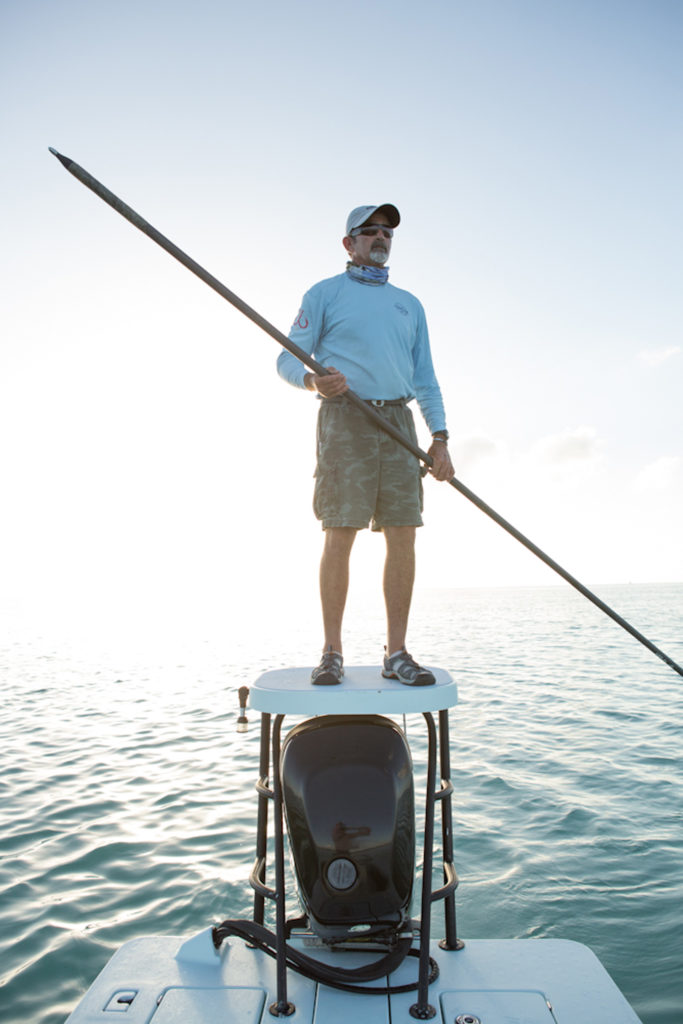
Photo: Eric Kiel
Brewer on the platform poling.
It was a formidable team. Fordyce caught his first fly rod bonefish on his eighth birthday, got his captain’s license when he was nineteen, and won the Don Hawley tournament one year later, the first time he entered it. Over the twenty-nine years he has guided, he and his anglers have won sixteen tarpon tournaments and have never come in outside of third place. As for Moret—both Huff and Klein told me that he is without question the best angler they have ever had in their skiffs.
Together Fordyce and Moret go over all the basics of the teamwork and intermeshing of skills between angler and guide that make for successful sight fishing from a boat. Fordyce describes how to keep your eyes scanning when looking for fish, how to look through the water rather than at it, how the guide uses the bow as twelve o’clock when telling his angler where on the clock face to cast. Moret demonstrates how to prepare for the cast—stripping out the proper amount of fly line into the cockpit and stretching it so it won’t tangle when launched, setting the drag on the reel, holding the fly correctly.

Photo: Eric Kiel
Fish's-Eye View
Sandy Moret makes a textbook case in the Florida Keys.
As soon as the two of them are set up (as luck would have it!), Huff swims up on his knees in the grass holding a stuffed bonefish named Albula, who commences to tail and feed with abandon some thirty feet off the bow of the skiff. Fordyce spots him! Points him out to Moret! Who makes a money cast two feet ahead of Albula, and the big bone pounces on the fly! As Huff makes his first run, Moret demonstrates how to strike with a strip of the line hand, how to clear the coils of fly line that fly off the deck, and how to fight the fish all the way into the boat—where Huff and Albula are released.
On the day before, Chico Fernandez had told me that becoming a good saltwater fly fisherman was a three-stage enterprise very much like becoming a good bow hunter: First you have to be able to shoot the bow competently; then you have to learn the habits of your prey and how to hunt it; and finally you have to put everything together to make the right shot at the right time. The little show-and-tell by Fordyce and Moret succinctly and vividly dramatized the independent lines of study in the school and how they come together. And for the students I talked to afterward, it seemed to close their two-day experience with the exactly right click of a Mercedes door.
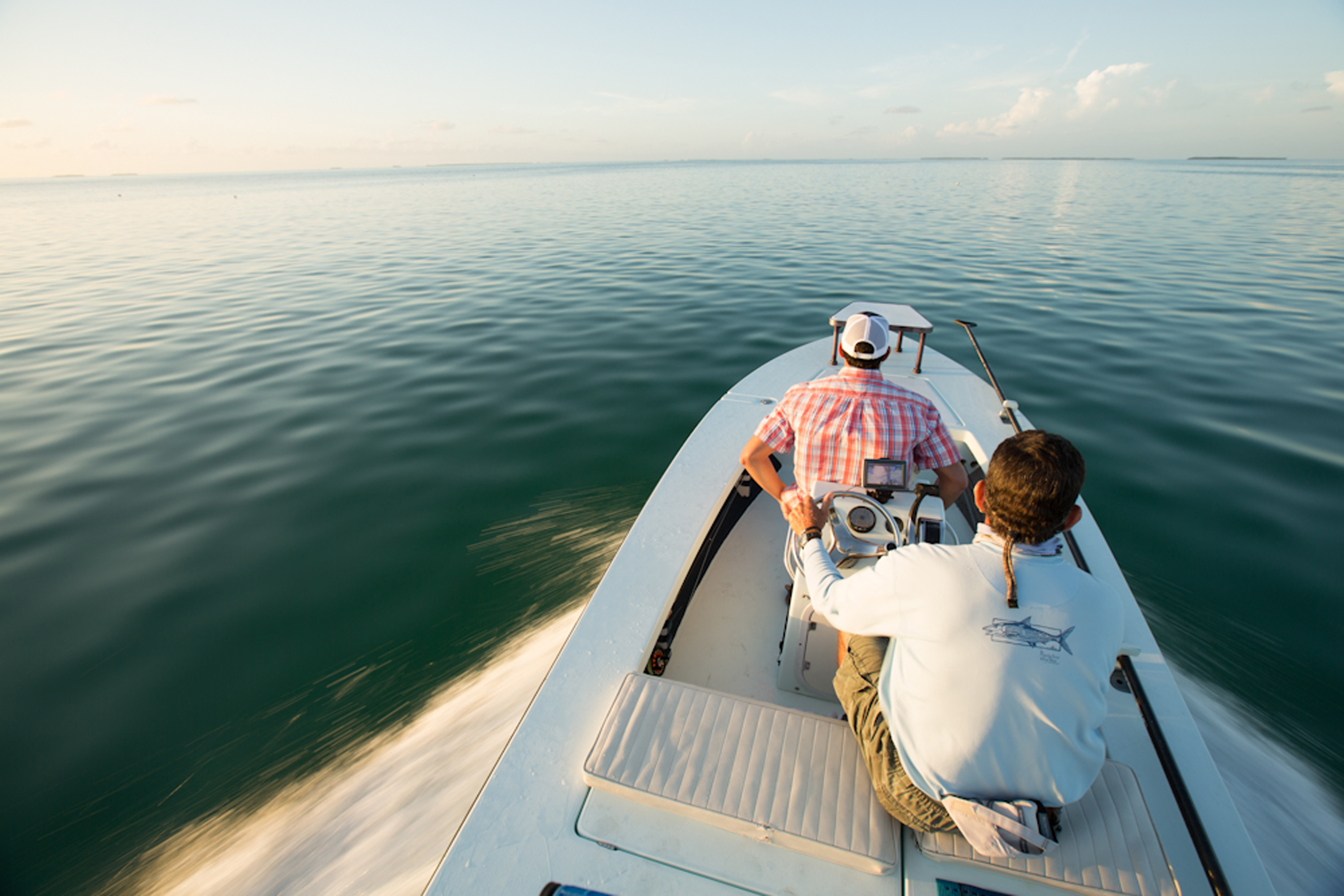
Photo: Eric Kiel
Students get three half-hour disquisitions on the tools of the trade and then they head out to the beach for the first of four hour-long casting sessions.
“This school is the best bargain in fly fishing,” one of the older ones told me on the way to his last casting lesson. “For less than the price of a good fly rod, after years of having no idea what I was doing, I finally feel like I know how to go catch a tarpon.”
Teaching people to catch a tarpon (or a bonefish, a permit, or a redfish) is, of course, the ultimate point of the Florida Keys Fly Fishing School. And on the following day I went out with the school’s founder and owner to see how he practices what he teaches.
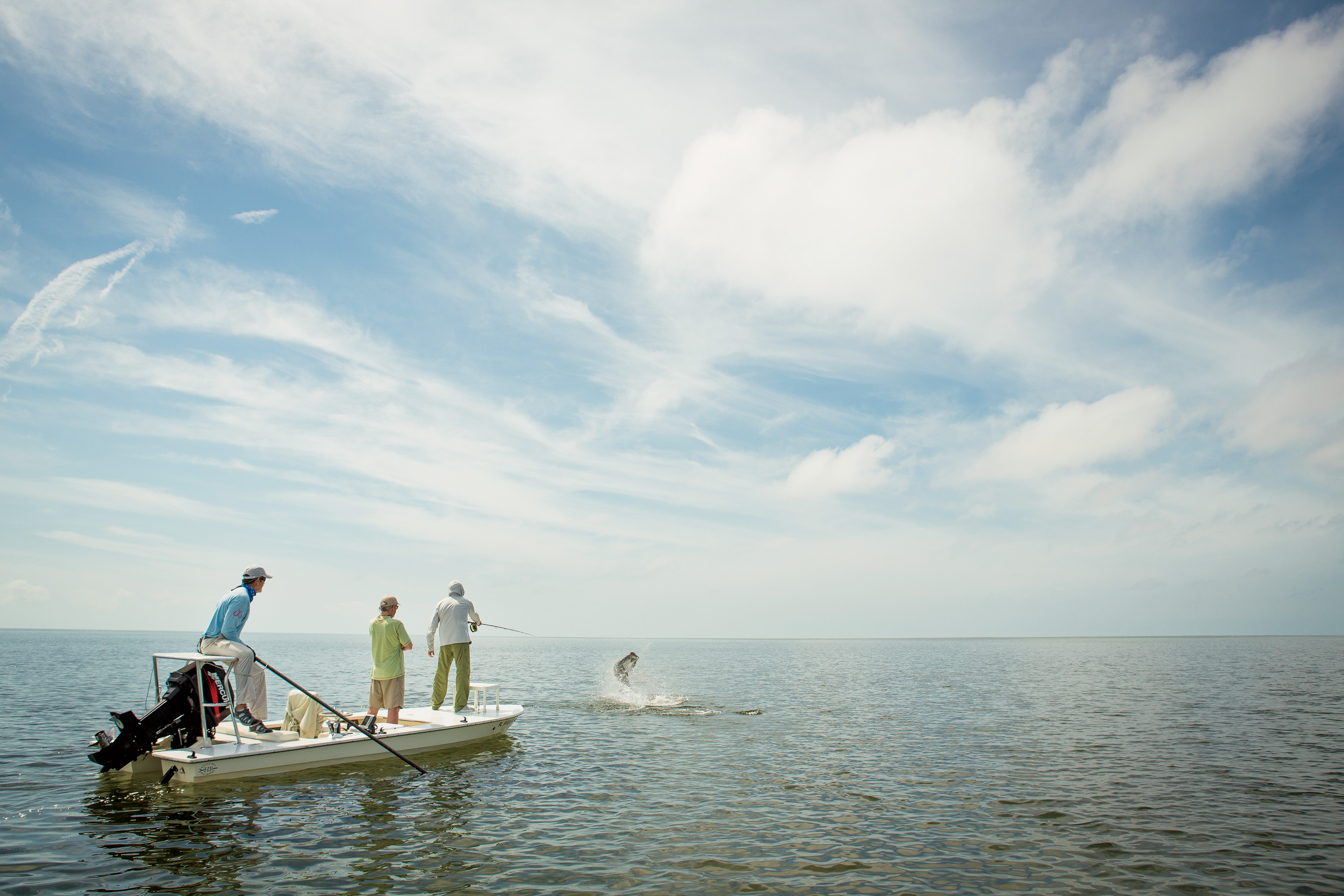
Photo: Eric Kiel
Fish On!
Moret works a large tarpon near the boat as the author (standing) and guide Craig Brewer watch the master in action.
After brief careers in real estate and the wholesale liquor business, Moret, who is now sixty-seven, moved to Islamorada in 1985 to “goof off and fish.” In ’88 he went to a seminar on saltwater fly fishing put on by Chico Fernandez and a group of other instructors in the Everglades, and decided to offer a similar thing in Islamorada, where the restaurants were better. In addition to running the schools, Moret and his wife, Sue, own and operate a world-class fly shop called Florida Keys Outfitters, and co-own a wine and liquor store and the legendary Green Turtle Inn. The man also fishes a bit. He has been eight times Grand Champion of the Keys’ two top tournaments, the Gold Cup Tarpon Tournament and the Islamorada Invitational Bonefish Fly Championship, and he has wet fly lines all over the Bahamas, Central America, the Seychelles, Christmas Island, Russia, and Palau.
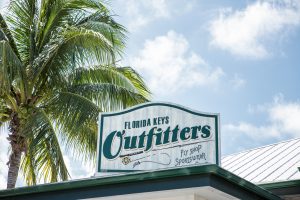
Photo: Eric Kiel
Moret and his wife, Sue, own and operate Florida Keys Outfitters.
So here we are, only ten minutes out of the marina on a hot, bright, dead-calm Monday morning—Captain Craig Brewer on the platform poling, and Moret in the bow holding an eleven-weight fly rod, line stripped out and stretched in the cockpit. The two men fish together regularly and, setting up in wordless concert, they seem implacably businesslike.
As Brewer poles, he and Moret scan the unwrinkled, sky-mirroring water, looking through it, not at it, for tarpon. And seeing them! Dozens of them, all moo-moos, finning, rolling, swimming idly around the skiff.
Tim Klein had told me that what distinguishes the very best tarpon anglers (he mentioned the novelist Carl Hiaasen and former Olympic skier Andy Mill, along with Moret) is really more an intuition or talent than a skill: the ability to “feed” the fly so irresistibly to a fish that it is all but forced to eat. (As if, I thought at the time in a little spasm of empathy, I were the tarpon and on the bow was my buddy Sam, the pit master at Demetri’s Barbecue.) At this talent Sandy Moret has few peers, but in the bright calm these sunbathing tarpon are distinctly not interested in any of the textbook casts he makes to them.
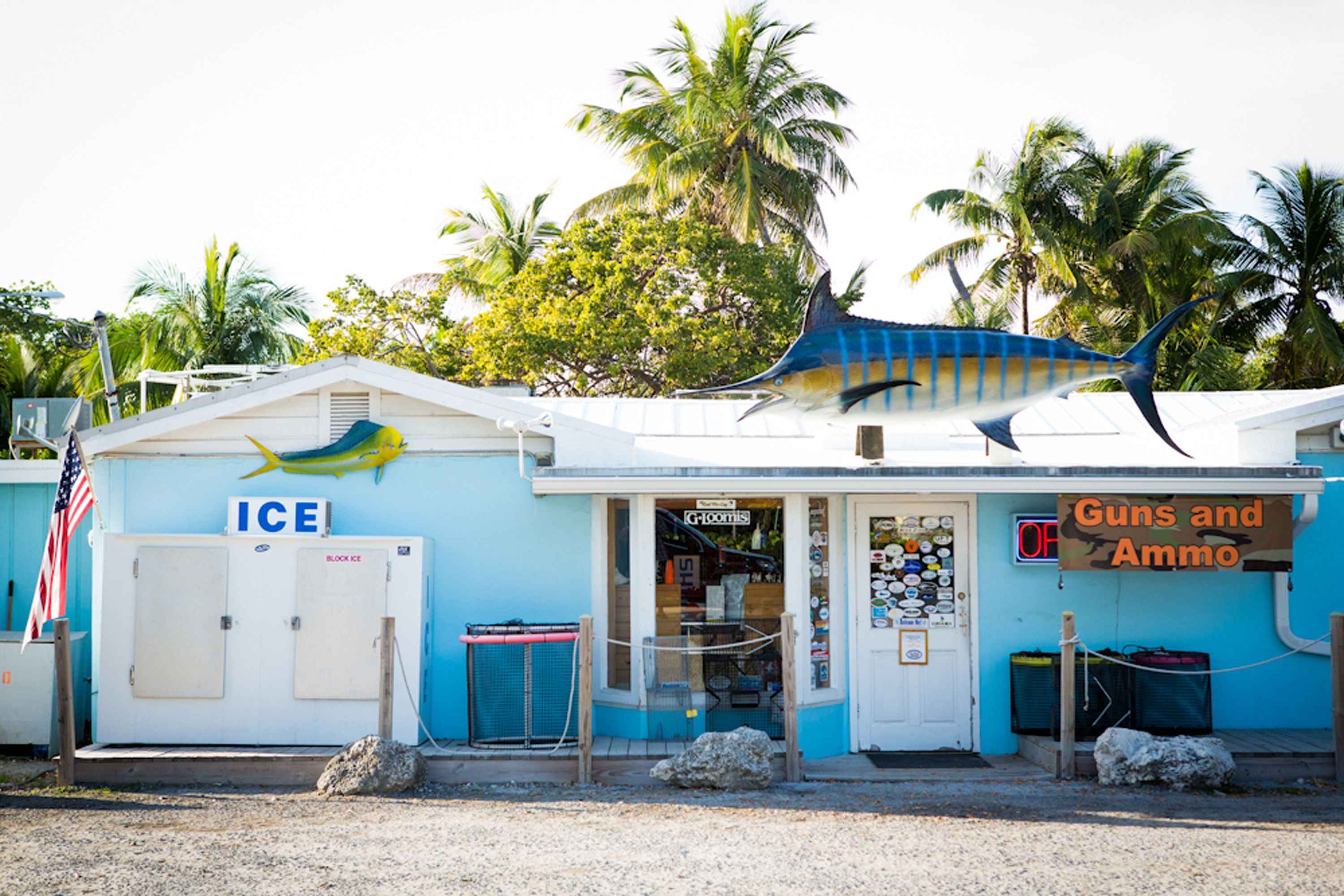
Photo: Eric Kiel
Until suddenly one of them is. And before I can even look up from my notebook, Moret is striking the fish and clearing his line—just as demonstrated yesterday, but now instead of Steve Huff running across the grass, he is attached to a 150-pound-plus tarpon convulsing in the air. “My God!” shouts Moret. “It’s a good thing they don’t roar. Nobody’s heart could stand it!”
While fighting Albula and Huff, Moret had emphasized the importance of keeping the rod low, just off of horizontal, so that the work of pulling on the fish is forced into the rod’s butt. Doing exactly that, within twenty minutes he has this beast of a tarpon rolled over, on its side, and ten feet away from Brewer’s gloved hands…when the fly’s hook snaps off.
Proving once again that in fishing—even when you do it perfectly, even when you do it just as it is taught at the Harvard of fly fishing schools—shit happens.
Photo: Eric Kiel
Sundown on the beach at the Islander Resort.
1 of 6
Photo: Eric Kiel
Bow to the Silver King
An angler gets real-world experience on a nice tarpon.
2 of 6
Photo: Eric Kiel
An angler gets real-world experience on a tarpon.
3 of 6
Photo: Eric Kiel
4 of 6
Photo: Eric Kiel
5 of 6
Photo: Eric Kiel
6 of 6


